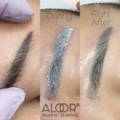Most important facts about Tattoo-Permanent Makeup Remover
Recent Posts
By Aleksandra Maniuse | 2017-10-07

Most important facts about Tattoo-Permanent Makeup Remover
Most important facts about Tattoo-Permanent Makeup Remover
Removers are suspensions that can bind pigment molecules stabilized in the skin and remove them from the tissues of the skin. Depending on the active component, there are acidic, hydrochloric and alkaline removers.
✔ Composition and principle of operation.
▶ Removers with acids in their composition penetrate into the place where the stabilized pigment is accumulated, bind to pigment molecules, destroys the link between them and skin cells and facilitate their extradition from tissues when exposed to a manipulation of machine or manual tool .
Manufacturers can specify active ingredients as an AHA in the product. By this name, the following acids are stated:
• dairy;
• glycolic;
• hydroxyacetic;
• hydroxy-succinic;
• apple;
• lemon;
• wine.
To enhance the properties of acid-based removers, resorcinol, salicylic acid, and barium sulfide are often added.
In fact, acids are coagulating substances. Therefore, a dense scab (crust) is always formed on the skin under the influence of acid-based removers. In 2011, the German Federal Institute for Risk Assessment advised against using lactic acid to remove tattoos, since the treatment involves health risks.
▶ Removers, which contain heavy metal salts, are now prohibited for use.
However, modern manufacturers include a sea salt concentrate into salt-based removers.
In this case, everything depends on the concentration of salt. If the salt gets on the wound surface in the form of a solution with 0.9% concentration (as in blood plasma, so this solution is called physiological), then there will be no unpleasant consequences for the wound. Moreover, the official medicine uses a similar solution for washing wounds. However, for removing pigments from tissues, the effect will also be zero.
A slightly higher concentration of salt in the solution (3-5-10%) (hypertonic solution), when applied externally, excretes pus well and has an antimicrobial effect. But for the purpose of removing pigments is also useless.
If the salt in its pure form falls on open wounds, it causes dehydration (dissolving, taking water from the cells of the body) – as a result, the cells are destroyed. Therefore, the probability of scarring when using salt removers is quite high.
▶ Alkaline based removers, such as sodium, potassium, calcium hydroxides, are used for the chemical removal of pigments of any complexity. If the acids are coagulating substances, the alkalis are the thinning ones. When using alkaline removers the probability of scarring or inflammation is possible only (!) when the client violates the rules of care after the procedure. Alkaline removers often contain CaO, quicklime. After the connection with water, quicklime passes with a large release of heat into the slaked lime. That is why, during the 72 hours after the procedure, the treated surface should not come into contact with water.
In addition, the area where the pigment was removed, should be lubricated with special oil-based products, applying a very thin layer.
✔ Advantages and disadvantages
As any cosmetic product, a pigment remover has advantages and disadvantages that must be taken into account.
▶ Acid products often cause allergies
▶ Acid removers can provoke a wet wound surface, which contributes to infection
▶ Alkaline bases over dry the dermis, and to avoid cracking, usage of emollient is a must
▶ Acid and salt-based removers work by provoking protein breakdown and severe dehydration of tissues, which often leads to rupture of areas of coagulated tissues. Subsequently, it is read visually as “minus tissue.”
▶ Alkaline-based removers break down proteins, forming alkaline proteins. They act more slowly and penetrate into the tissues much deeper than acids and salts. Therefore, the work of a non-alkaline based remover is carried out on the surface of the skin, without unnecessary injury, but with greater efficiency than when the remover is operated on an acidic or salt basis.
▶ If used unprofessionally, acid, salt and alkaline removers can lead to chemical burn!
